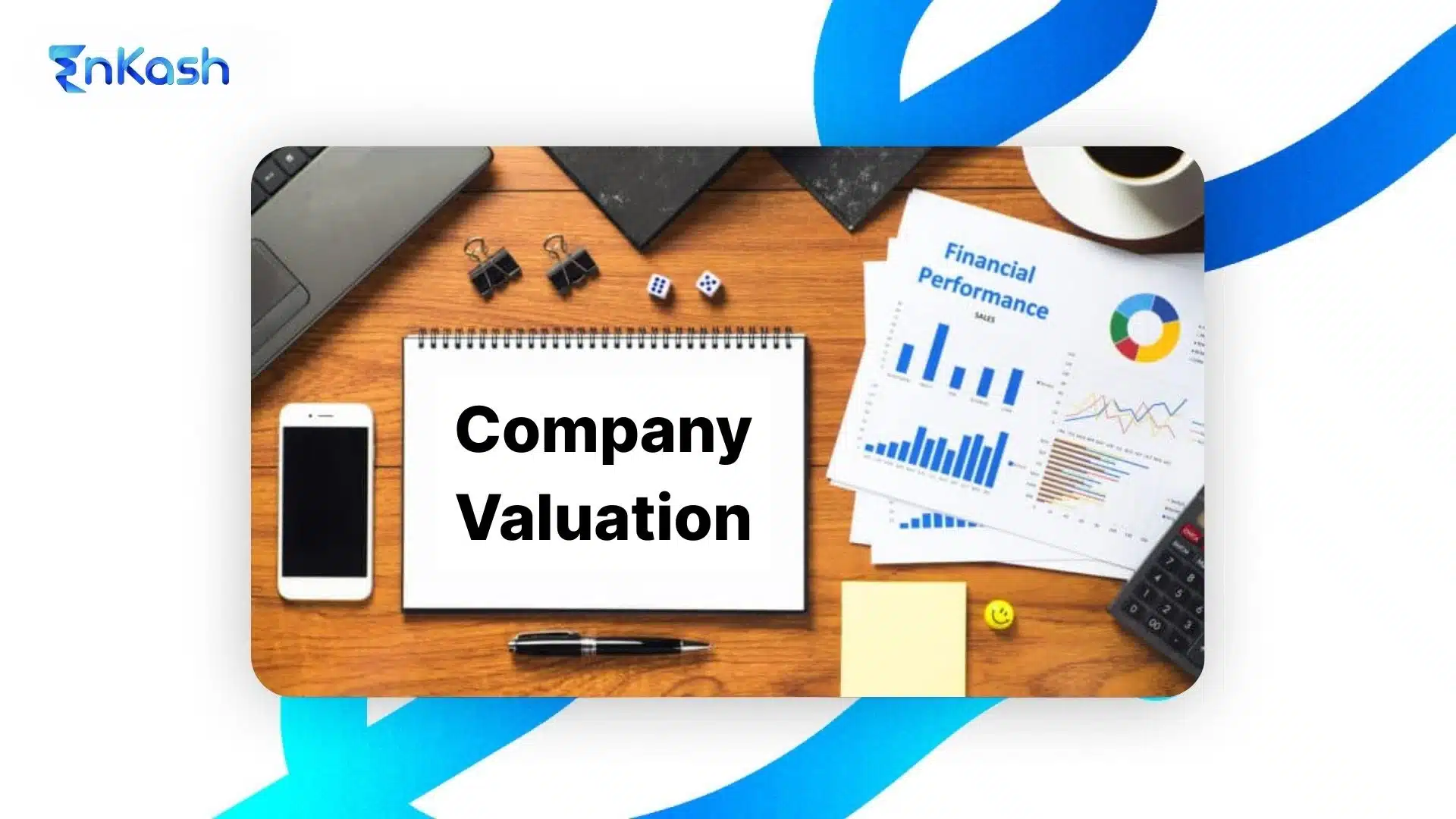Introduction
Company valuation plays a crucial role in deciding financial matters, such as raising capital, selling a business, or investing in one. It determines the economic worth of a company based on what assets and liabilities a company has, its revenues, and its market potential. The very importance of business valuation rests within the minds of startup owners, investors, and financial analysts; from helping with mergers and acquisitions to finding an agreeable price per share, company valuation sets a clear view on the worth of a business. This blog will explore company valuation, its definition, types, and ways to find the value of a company.
What Is Company Valuation?
Company valuation is a process undertaken to establish the economic worth of a business at a particular moment in time. A simpler terminology could be setting forth the question: “In the present moment, if someone wanted to purchase it today, how much would the business be worth?” It becomes critical in mergers, acquisitions, capital raising, issuing company shares, or even applying for business loans. One must realize: company valuation is much more than simple profit or revenue considerations; if we unwind it, it accounts for assets, liabilities, the company’s potential to generate income in the future, its status in the market, and intangible items such as brand name or intellectual property.
Another phrase often used interchangeably with company valuation is business valuation, which refers to the general field that assists stakeholders in determining the financial well-being of an entity and the possible risks or opportunities it possesses. Valuation knowledge gives investors, founders, and advisors the ability to make good judgments that will reflect in the business’s being fairly or unfairly valued in operational transactions. Knowing company valuation meanings is an essential factor for performance benchmarking and in providing the entrepreneur with a means to organize his/her time in order to track business progress. Overall, correct valuation forms the basis of trust, setting the strategy, and long-term financial triumph and stability.
Read more: What is a company?
Common Company Valuation Methods Explained
Understanding the various methods of company valuation is vital since selecting the appropriate valuation method determines the actual worth of your business. Methods differ depending on industry, financial standpoint, and business stage. The most commonly used methods include:
1. Asset-Based Valuation
It calculates the net value of a company’s assets after deducting its liabilities. This is mostly applicable to companies whose main assets are real estate, machinery, or inventory.
Formula: Valuation = Total Assets – Total Liabilities
Suitable for liquidation or for businesses that have little income but have high value in tangible assets.
2. Earnings or Profit-Based Valuation
In this case, the company is valued based on previous and projected earnings, as investors usually employ earnings multiples to fix their values, the most popular being Price-to-Earnings (P/E).
The formula goes like valuation = earnings × industry P/E ratio.
Usually, a company valued this way is one that makes a profit and supplies a fixed income stream to its investors.
3. Market-Based Valuation
This method attempts to value the company by analyzing businesses similar to it in the industry that have recently been sold or are being traded in the public markets.
The method involves CCA or Precedent Transactions Analysis.
This method also considers current market sentiment and the competitive landscape.
4. Discounted Cash Flow (DCF)
Often referred to as a forward-looking method, it assesses the present value of expected future cash flows. It suits startups and businesses with considerably high growth potential.
Each of these valuation techniques falls under the broader types of valuation methods and serves a particular purpose depending on the business context. If chosen right, it reflects an accurate and fair evaluation of a business.
How to Calculate the Valuation of a Company: Step-by-Step
The accurate appraisal of a business is necessary for making all-important decisions, be it an investment choice, an entrepreneur’s route, or even advice from a financial consultant. Should you not know how the valuation of a company is done, then here is a step-by-step guide to get you through.
1. Choose the Best-suited Valuation Method
The very first step in doing a valuation is deciding what methodology would be the best regarding the nature of the company, the industry in which it operates, and its financial history. Some of the accepted company valuation methods are as follows:
- Discounted Cash Flow (DCF): Projects future cash flows and discounts them to present value.
- Market Comps (Comparable Company Analysis): Compares your business with similar companies in the same industry.
- Asset-Based Valuation: Values the company based on total assets minus liabilities.
2. Gathering and Analysis of Financial Data
Once the method is chosen, gather the right financial information, including revenues, operating costs and expenses, net profit margins, growth rates, and the trends for your industry. This information is then used in the formula for company valuation.
3. Apply the Relevant Formula
Each valuation method uses its respective formula. For example:
Profit-Based Formula:
Valuation = Earnings × Industry P/E Ratio
This method is useful when there are stable profits and a recognized industry benchmark.
DCF Formula (Simplified):
Valuation = Σ (Future Cash Flows) / (1 + Discount Rate)^n Asset-
Based Formula: Valuation = Assets – Liabilities
Knowing these valuation techniques can help you select the right one for you.
4. Adjust for Market and Industry Trends
One should always fine-tune the valuation on
- Competitor benchmarks
- Market growth rate
- Regulatory environment
- Risk factors
These external factors can significantly impact the company’s final valuation and, therefore, its actual worth in the market.
5. Calculate the Equity-Based Valuation When Applicable
Many company owners want to know how to calculate the valuation of a company based on equity. The formula is very straightforward:
Equity Value = Share Price × Number of Outstanding Shares
This valuation type comes in handy for investors assessing ownership value and are interested in issuing shares. It also assists in evaluating the valuation of a company on the public market or in investment rounds.
6. Interpret the Final Result Carefully
This step proves crucial. Once calculations are complete, analyze the results. Optionally, cross-check using alternative methods, maintaining a balanced perspective. This validates your company valuation and makes it acceptable, relying on sound financial standards.
Top Business Valuation Approaches You Should Know
Choosing the right valuation approach is critical when seeking funding, planning an exit, or doing a strategic review. Here are the top business valuation approaches commonly used by professionals.
1. Income Approach
- The emphasis is placed on the capacity of a company to earn a profit in the future. Discounted Cash Flow (DCF) analysis is among the most commonly used income-based valuation methods.
- DCF approximates the present worth of expected cash flows.
Best-suited for startups and high-growth companies that have predictable financial models. - Intrinsic value is presented relating to operational performance.
The method provides business valuation details from the perspective of earning capacity as opposed to just present assets.
2. Market Approach
- The market approach uses data from similar businesses to estimate value. One commonplace analytical tool in this realm is the Comparable Company Analysis (CCA).
- It focuses on companies of similar size in the same industry and geography.
- It often utilizes valuation multiples such as P/E (Price-to-Earnings), EV/EBITDA, etc.
- This is a very common method to evaluate an established business that faces active competition.
- Among various ways of valuing companies, this method certainly proves very useful in benchmarking a business against its industry peers.
3. Cost Approach
- This approach calculates the value of a business according to the cost required to build it from scratch.
- More generally used in an asset-heavy field such as manufacturing, construction, or utilities.
- Raw assets such as buildings, machines, and land are considered.
Formula: Valuation = Replacement Cost – Depreciation - This valuation method is suitable for businesses with significant investment in physical assets but with limited future earning potential.
4. Matching Method to Business Type
Choosing the appropriate model also depends on how your business is structured:
- Startups: Lean more on income-based approaches like DCF.
- Asset-Heavy Businesses: Tend to favor cost-based valuation
- Public Companies: Market-based models thrown in with trading multiples.
Real-World Examples: Applying Company Valuation Formulas
While the theory behind company valuation formulas is important, it is much clearer to see how these formulas are applied in real-world situations. Let’s have a look at these valuation scenarios with examples.
1. Price-Earnings Ratio Application
You are evaluating a tech startup earning ₹2 crore annually. If the average P/E ratio in that sector is 20, the valuation would be:
Company Valuation = ₹2 crore × 20 = ₹40 crore
This method is commonly used when a company has steady profits and belongs to a well-established industry. It provides a quick idea about pricing in the market through such company valuation formulas.
2. Equity-Based Valuation Method
Now, suppose this company has 4 lakh outstanding shares, and a single share is determined to be worth ₹1000. The equity-based value of the company can be calculated as:
Value Per Equity Share = ₹1000 × 4,00,000 = ₹40 crore
This is how investors often calculate the valuation of a company from its equity, especially when raising funds or analyzing dilution of ownership.
3. Use Across Business Types
The valuation formula is not just applicable for startups but also considered to determine worth for SMEs, medium-sized enterprises, and large industrial installations. When buying shares or obtaining investors for a merger or your own business, know how to value an enterprise so that you will be able to stand on your own when making decisions.
Choosing the Right Valuation Method for Your Business
Business valuation simply does not have a single approach. Depending on the nature, size, and stage of growth of your company, the best method for valuation will be decided. Below is the method to choose an approach for your business.
1. Startups: Focus on Future Potential
Startups normally have little or no historical information but possess high growth potential for the future. Therefore, methods such as Discounted Cash Flow (DCF) or revenue-based valuation are suitable.
The DCF Method values a business entity based on the estimated future cash inflows discounted to present value.
Revenue multiples are applied when there are nearly zero profits but very high revenue growth.
These methods of company valuation try to reflect the real potential of a business still not mature.
2. Manufacturing Firms: Asset-Based Valuation Works Best
Manufacturing firms that have many physical assets-e.g., machines, inventory, or land-consider an asset-based valuation.
It finds value by subtracting liabilities from the total asset value.
It is applicable when tangible assets contribute largely to worth.
These are traditional types of valuation, frequently employed when earnings are irregular or market prices are difficult to predict.
3. Listed companies: Market approaches
Market capitalization or comparable company analysis is often used to value publicly listed companies.
Market Cap = Share Price × Number of Outstanding Shares
In a Comparable Company Analysis, you compare your target company to other similar companies in the same sector, considering their respective P/E, EV/EBITDA, etc.
These methods of valuation exceptionally consider market sentiments and investor expectations, prominent for publicly listed companies.
4. Matching Your Valuation with the Objective
Valuation methods differ when the valuation purpose changes:
For Funding, Most investors working on valuation prefer earnings or the market approach.
- For Exit and Acquisition: Buyers in exits and acquisitions may be more comfortable with asset-based or cash flow-based valuations.
- For Internal Strategy: A combination of methods can be employed, since the more the better. Getting familiar with various valuation methods will help you choose one in accordance with your business objectives and industry standards.
5. Accuracy and Credibility
Using correct company valuation methods offers a reasonable financial projection that is believable and well-attested, so as to draw the right investor and instill confidence in fellow stakeholders.
Some Common Mistakes to Avoid While Valuing a Business
Understanding how business valuation works is important for making the right financial decisions. Even then, a lot of business owners and some professionals fall into these traps when attempting to implement company valuation methods. Avoiding these mistakes will go a long way in reflecting your company’s worth more accurately.
1. Ignoring Liabilities
One major error in business valuation is the emphasis on assets and revenues, while liabilities are just dismissed. Loans, taxes unpaid, or pending dues cost a company dearly in net worth. Always subtract liabilities from the assets value for an authentic result.
2. Overestimating Future Cash Flows
An unfortunate side effect of entrepreneurship is the tendency to forecast future earnings too optimistically. Confidence, however, is a great quality, yet inflated cash flow numbers lead to unrealistic valuations. It is always good to remain down-to-earth and project data that are anchored in records and prevailing market conditions.
3. Using the Wrong Valuation Method
Not every business solution fits every model. Choosing improper company valuation methods, such as applying a market-based approach to an unusual or niche business, will skew the results. Every industry and business stage requires an apt valuation technique.
4. Leaving out Intangibles
While calculating for business valuation, many neglect intangible assets such as brand value, customer loyalty, or intellectual property. These intangibles can themselves comprise a very large chunk of a company’s valuation, especially in the case of service or technology-based companies.
5. Ignoring Market Trends
Valuation is not just about internal figures. The neglect of external elements like market demand, competition, and economic changes might render the valuation irrelevant or old-fashioned.
Avoiding these pitfalls will ensure that your business valuation is accurate and credible and serves a worthwhile strategic purpose.
Conclusion
Although the company valuation is fundamental to founders, investors, and financial advisors for making intelligent decisions, from understanding what company valuation means to learning how to calculate a company’s equity valuation and everything in between, every insight matters in this matter. Depending on the situation, the best methods of company valuation and valuation techniques for assessing any business are selected. An accurately prepared business valuation enables the identification of growth potential, the minimization of risk, and the strengthening of strategic planning. At EnKash, we think that financial clarity starts with being aware of a company’s true worth. Make the first move toward long-term business success today and empower your financial journey with EnKash.












